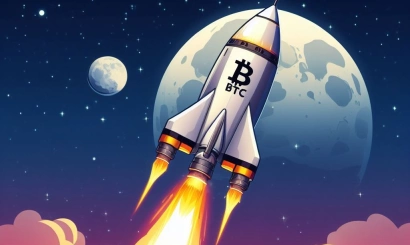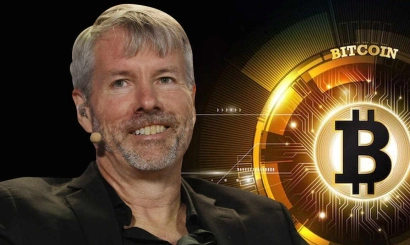When Bitcoin Becomes Money: Key Points from Adam Back's Interview
Adam Back, the CEO of Blockstream, shared insights in an interview about when Bitcoin will become money, why it is being used as a store of value, and the technologies being developed based on the leading cryptocurrency.
The head of one of the key companies in the Bitcoin market, Adam Back, discussed how Bitcoin has evolved from a payment system to a store of value and what technological upgrades are expected for the leading cryptocurrency in the future.
Adam Back, co-founder and CEO of Blockstream, a British cryptographer, and computer scientist, is widely known for his invention of Hashcash in 1997 — a proof-of-work system that underpins Bitcoin mining. He also played a role in the early development of Bitcoin. He was one of the first people to be contacted by Bitcoin's anonymous creator, known by the pseudonym Satoshi Nakamoto.
Many members of the community believe that Adam Back himself is Satoshi Nakamoto, pointing to his expertise in cryptography and his pre-Bitcoin developments as evidence. However, Back has repeatedly denied these claims.
Blockstream is a leading developer of Bitcoin scaling technologies. Its products include fast and confidential transactions, issuance of digital assets such as stablecoins, and tokenized real-world assets (RWAs).
At the end of October, Blockstream raised $210 million in its latest funding round. Since 2014, the company has raised at least $610 million in four rounds, with investors including Kingsway Capital, the Bitfinex exchange, Baillie Gifford, and Blockchain Capital.
Store of Value
Many consider Bitcoin only as "digital gold" that should be held to increase capital over the long term. However, part of the community believes that as technological capabilities develop, Bitcoin could become something more on the financial markets.
Staking and Beyond: Who Benefits from Bitcoin's DeFi Projects?
Back believes Bitcoin's role as a store of value became more prominent due to the inflation of national currencies in developing countries: “People started thinking about inflation after COVID, as our currencies in general seem unstable. I think you’ve seen the rise in emerging markets yourself.”
Back acknowledged the utility of stablecoins in the context of Bitcoin's relatively "slightly unstable" value, which he considers a temporary phenomenon due to the rapid adoption of the technology. For many people, using Bitcoin as a means of payment is problematic due to its volatility.
The Blockstream CEO also mentioned that the company is working on several projects that could see widespread adoption in the retail payment space.
"Stablecoins" are tokens pegged to assets like the US dollar, gold, or the euro. These tokens are used by traders to move digital assets between exchanges and also in consumer payments. Unlike Bitcoin or Ethereum, their value is not subject to the same price fluctuations depending on the market situation.
Furthermore, due to hacks and frauds on cryptocurrency exchanges and services where users had trusted their assets, there is a need for trading solutions based on Bitcoin. These solutions allow users to maintain control over their funds without relying on third-party storage.
Back mentioned the Mt. Gox and FTX exchanges as illustrative cases where user trust resulted in massive losses. Mt. Gox filed for bankruptcy in 2014 after losing 850,000 Bitcoins (nearly $60 billion at the time) due to a series of hacks. FTX filed for bankruptcy in November 2022, with fraudulent activities by its executives leading to multibillion-dollar losses for users.
As a solution to the trust issue with exchanges, Back pointed to atomic swaps and so-called cross-wallets. These mechanisms allow Bitcoin to be exchanged for other assets without relying on centralized exchanges or services that require users to transfer Bitcoin to an organization's account for further transactions. However, these technologies are still in deep development.
Bitcoin for Payments and Financial Market Transactions
Back discussed how Bitcoin is already being used for payment needs and financial market transactions. Blockstream is developing a range of solutions through its flagship product, the Liquid Network, an overlay network built on top of Bitcoin.
According to Back, the company has already created an accounting system for credit institutions and their clients, where credit documents and collateral certificates are issued on the blockchain. He noted that the capital for these operations comes from several public banks in the US, and "hundreds and hundreds" of both individuals and businesses are already clients.
Back acknowledged that, while there is demand for the use of their products based on Liquid and similar solutions like the Lightning Network in retail payments, adoption is growing at a much slower pace compared to the overall market capitalization of Bitcoin and the widespread use of stablecoins.
Shift in Funding
Back pointed out that there has recently been a shift in venture funding towards Bitcoin development compared to other blockchains. This is likely due to the approval of Bitcoin-based exchange-traded funds (ETFs) in the US.
The first spot Bitcoin ETFs in the US were approved in January 2024, after more than a decade of attempts to register such products. The launch of these ETFs opened up the possibility to trade Bitcoin legally in the form of shares on regular brokerage accounts, which prompted a surge of capital into the market and became one of the catalysts for Bitcoin's price growth in 2024.
The largest asset managers in the world, BlackRock and Fidelity, launched their own Bitcoin ETFs, alongside other players in the financial and crypto markets. Spot ETFs now hold over 5% of the existing Bitcoin supply.
Back believes that in the past, venture capital heavily favored other networks due to the phenomenon of tokenization, where projects needed to create a successful product that could meet the market: "They could sell tokens as soon as liquidity appeared."
Bitcoin Over Altcoins
Back also believes that the shift in investment flows may have come from the oversaturation of altcoins: "There used to be 20,000 coins, but now there are more than 3 million, including meme coins." A significant portion of capital from interested investors is now in Bitcoin, and they are essentially ready to invest directly by transferring the main cryptocurrency instead of using national currencies.
Back's views align with those of Hasib Qureshi, managing partner of the crypto venture fund Dragonfly, who noted the increasing interest in Bitcoin developments from mining companies that hold large amounts of the cryptocurrency.
In conclusion, Blockstream's CEO pointed to a change in the rhetoric surrounding Bitcoin from both regulators and traditional financial institutions and banks. With the approval of ETFs, issuers and lobby groups are now focused on expanding the infrastructure surrounding Bitcoin.







